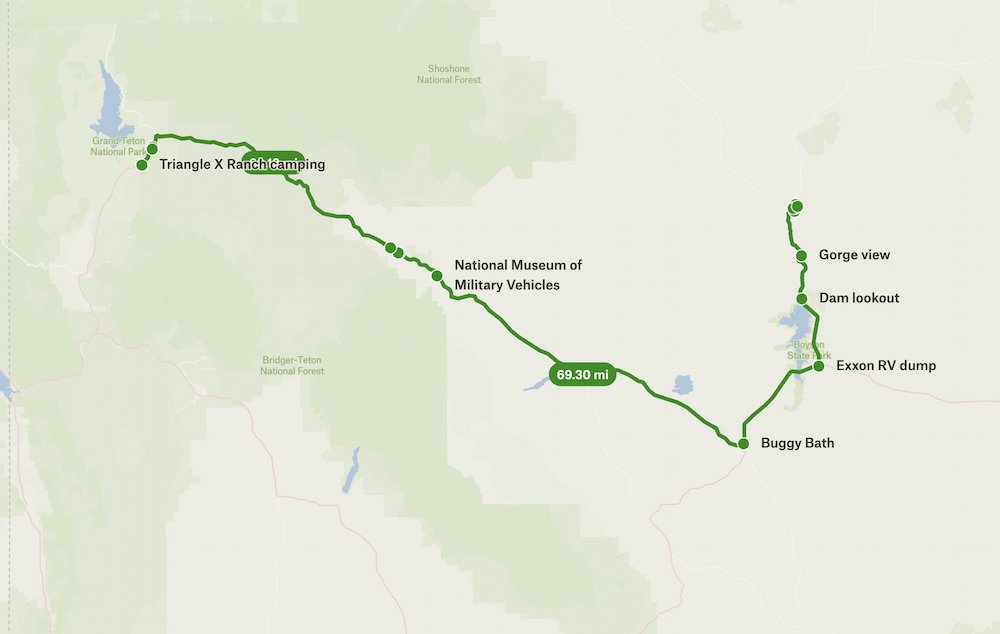Lisette's love of tea means that she has amassed a lot (but perhaps for her, still room for more) types of tea in the RV. This morning, she realized that one of the loose leaf packets of chai from Aussie brand T2 was almost finished, which she'd bought over a year ago. Because Michael likes to have coffee in the morning, she proceeded to finish the bag, downing 3 cups of milky hot chai first thing in the morning. BIG MISTAKE. The overwhelming dosage of dairy and spicy chai put Lisette into a state of discomfort, clutching at her belly like it's no lactose's business, and remaining with her for the majority of the day.
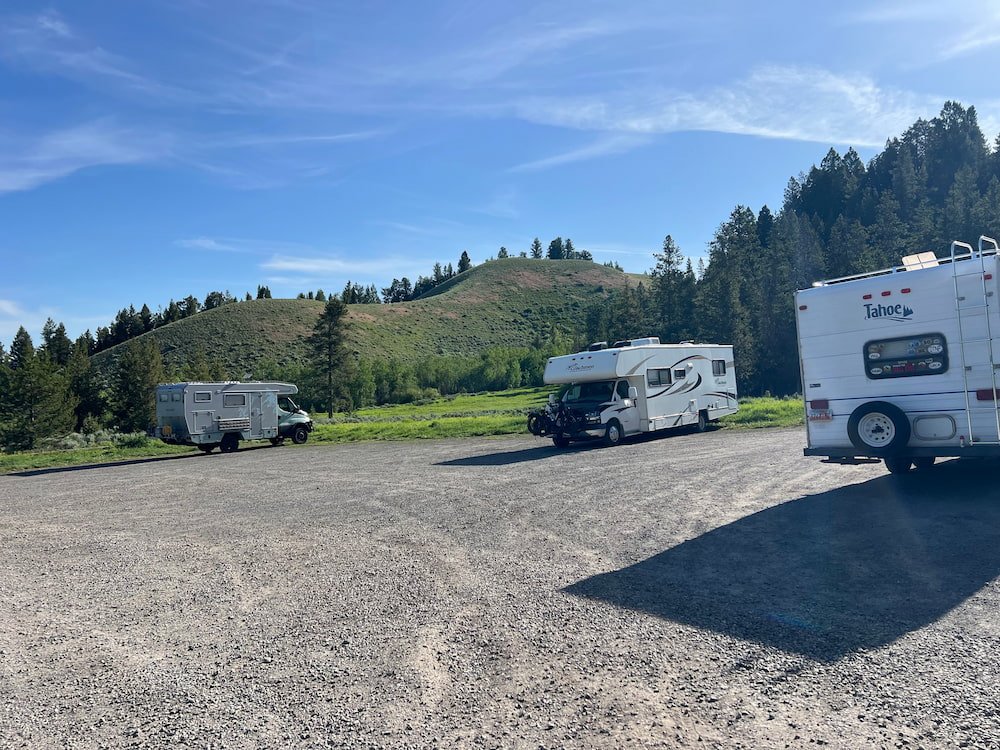
Dubois: Jackalopes and Military Might
As a somewhat helpful distraction, we drove across US Highway 26, passing through the Shoshone National Forest, the first federally protected National Forest in the country, covering nearly 2.5 million acres, with rugged backcountry, alpine lakes, but no wildlife in sight. Soon we arrived in the small town of Dubois, with its Wild West charm. The Exxon Country Store, apparently has the largest jackalope exhibit, complete with a large jackalope statue at the front to sit on (yep, Lisette did that for the photo op), a huge, stuffed jackalope head inside, as well as a ton of souvenirs. Admittedly, Lisette thought the exhibit could be bigger! We looked it up because we weren't sure of its origins, but the jackalope is a mythical creature in North American folklore, apparently popularized by two brothers in the 1930s who grafted deer antlers onto a jackrabbit carcass and sold this to a local hotel in Douglas, Wyoming. So it makes sense that the largest exhibit would be in this state.

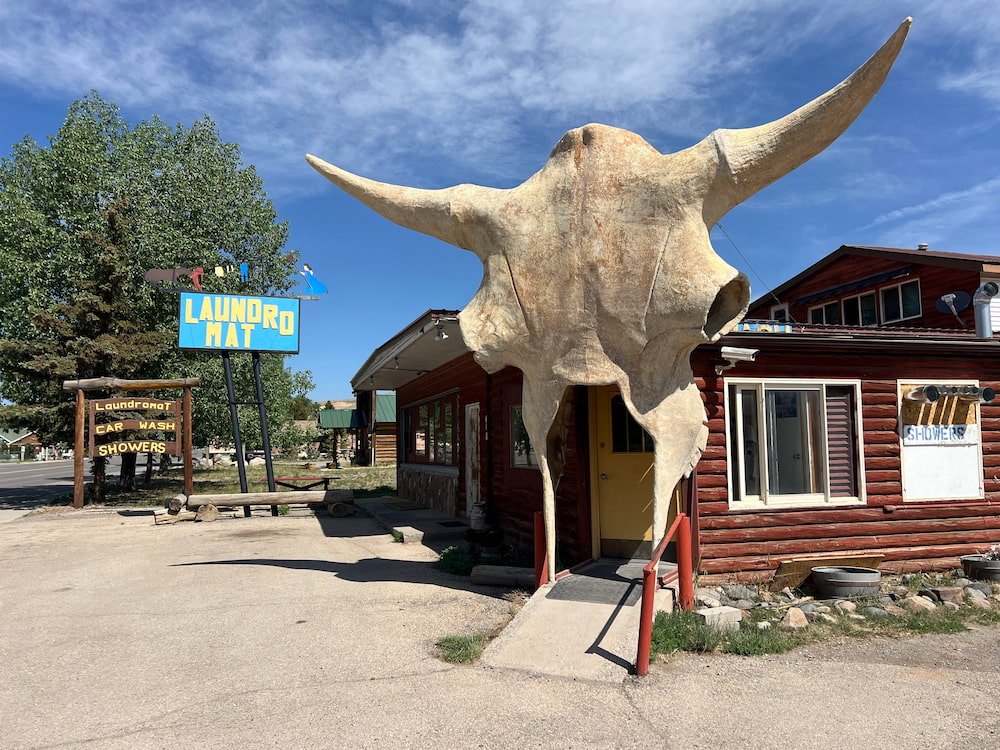



Less than 16 kilometers (10 miles) drive away, heading east, we saw dozens of military vehicles parked outdoors, ranging from World War I tanks to more modern vehicles. We had stumbled upon the National Museum of Military Vehicles, a military history museum that's home to hundreds of restored military vehicles, historic firearms, and rare artifacts. Lisette was still getting over her lactose and spice overdose, so she stayed inside while Michael toured the outside of the museum, looking at the extensive display of vehicles. The museum is open year-round, and costs $23 per adult.

Scenic Central Wyoming
We continued along US Highway 26, then veered northwards on US Highway 20/Wyoming Highway 789, making our way through central Wyoming. We were amazed to see beautiful and rugged mountains, with deep canyons flanked by limestone, sandstone and dolomite cliffs that stood at over 760 meters (2,500 feet). We'd arrived at Wind River Canyon, a gorgeous and dramatic gorge that stretches for about 32 kms (20 miles), with and is flanked by towering limestone, dolomite, and sandstone cliffs that rise up to 2,500 feet above the river. The exposed geologic layers here is over 2.5 billion years old, making it some of the oldest exposed rock in North America! The area is also a popular spot for trout fishing, and white water rafting. Naturally, with all of these factoids, we had to stop and take a few photos of this scenic spot.
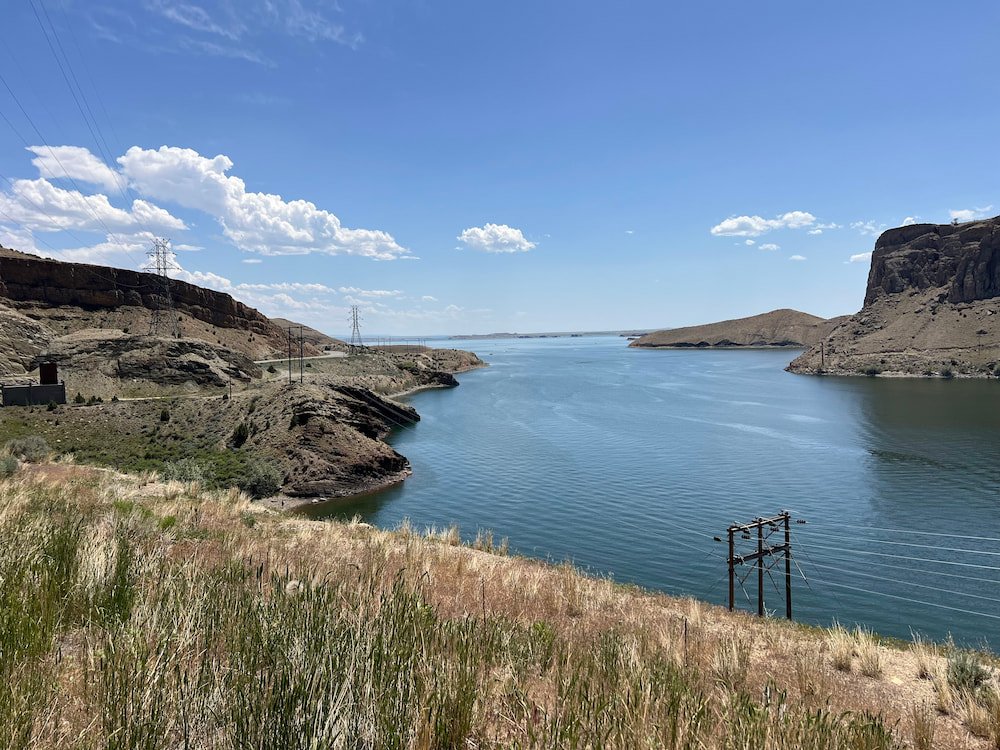

We had to stop at a couple of places to do an RV dump (the first one had a lock on it, and nobody was around), but at the first stop Michael realized that we seemed to be leaking from somewhere in the front hood. It was a sweltering hot day, so we figured that it could have something to do with the air conditioning, which was running but would omit a musty smell when we turned it on. We'd have to check it out with a mechanic soon.
Thermopolis: Fossils and Hot Springs
A little further north, we arrived at the small town of Thermopolis, in Hot Spring County in central Wyoming. Thermopolis is Greek for "hot city" and the name could not be more apt: it has numerous mineral hot springs. The temperatures were somewhere in the mid-30s Celsius (about 95 degrees Fahrenheit), so there was absolutely no way we'd be soaking in boiling hot springs, but we found the Visitor Center to be extremely helpful, with the lady working there more than happy to chat extensively to us about all the things we could do and see. Lovely small town hospitality, for sure.

To escape the heat, we headed to the Wyoming Dinosaur Center, which is one of the few dinosaur museums in the world that has excavation sites within driving distance. There are even opportunities to visit active dinosaur dig sites to try an uncover more bones! The center has a ton of fossils, including nearly 20,000 dinosaur bones from Thermopolis, as well as fossils from around the world, including Australia and a lot from the Solnhofen region in Bavaria, Germany. We had no idea that Germany was home to so many fossils! The fossils on display included dinosaurs, but ancient birds, sea turtles, fish, and other marine life.
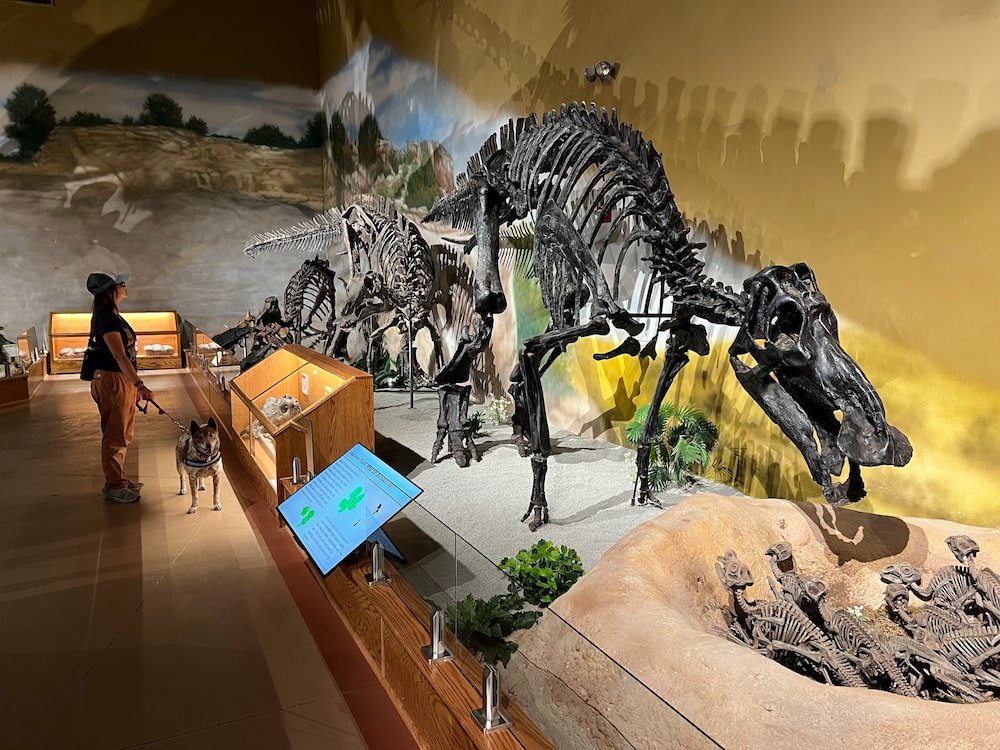

At Hot Springs State Park (which is a free state park), unsurprisingly the area to go and soak at the mineral hot springs was empty, but there were people paying to hang out at the public soaking pools nearby. We walked around the area, and also over to the Mineral Terrace boardwalk to see the hot springs close up. Sheila walked along with us so that she could at least be outside, but perhaps because she was so hot she licked and drank a bit of the hot spring water as we were making our way along. Uh-oh....


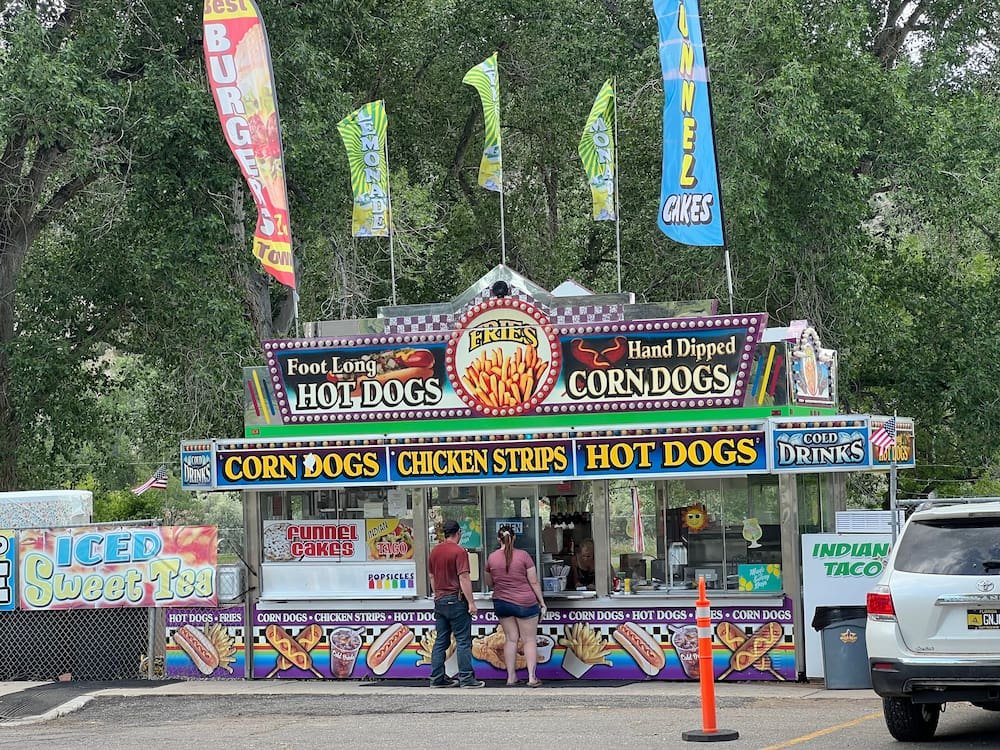




Past the hot springs, there's also the Swinging Bridge--a suspension foot bridge that offers views of the Mineral Terrace from the other side, showing off its vibrant white and orange colors from a distance. On a hill close to the bridge, the words "World's Largest Mineral Hot Spring" with an arrow pointing towards it are painted on the hill. We're not sure if it happens a lot anywhere else in the world, but we have definitely noticed that it's commonplace for hills in the US to have letters and numbers painted on them, indicating everything from the name of the town, to commemorating graduation dates of the local high school, to pointing out a nearby tourist attraction. If you read this and know of where else this happens in the world, we'd love to know!


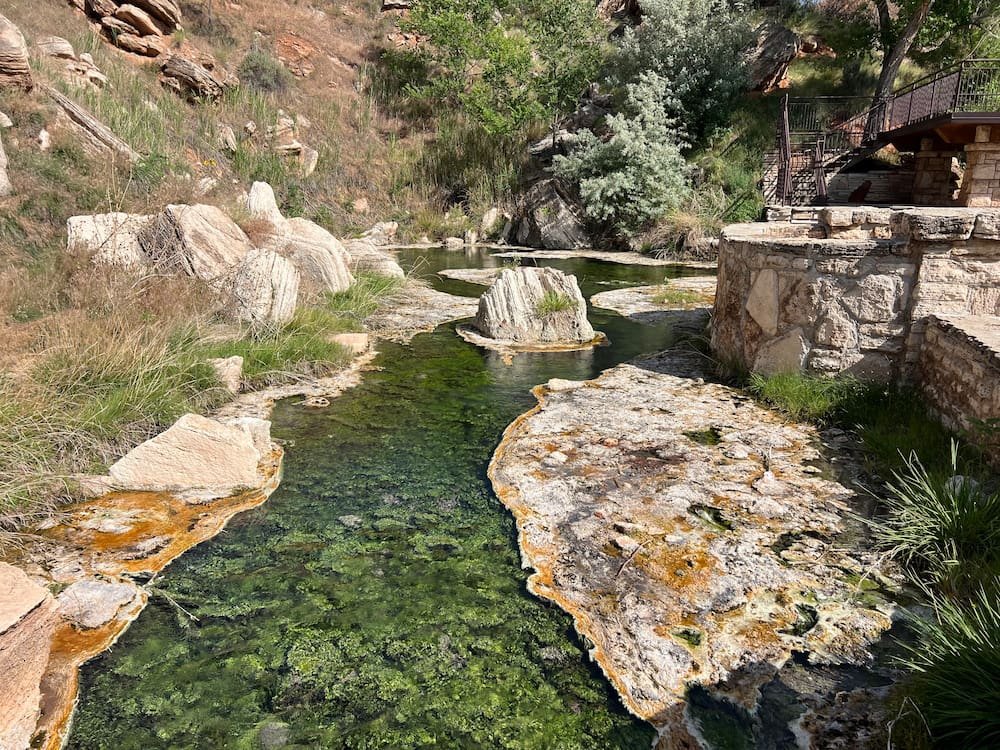
We headed back to the RV, passing a lake with overexcited cod splashing by the shore, mouths rapidly moving to eat the Cheerio cereal a girl was throwing into the lake to feed them. There's fish feed that costs 25 cents nearby, but why pay when it seems that boxes of cereal from home do just as well?

Not far from Hot Springs State Park, we found a space to park by the water, which we hoped would help us cool down as the sun set. The only tradeoff when it gets dark is that mosquitos start to emerge now that it's summer, so we're needing to use our electric bug zapper racquets, mosquito spray, and cream for when the bites still inevitably happen!
Route Map
